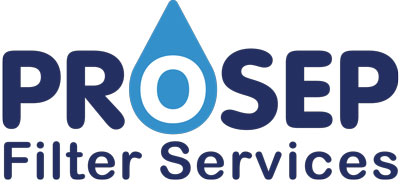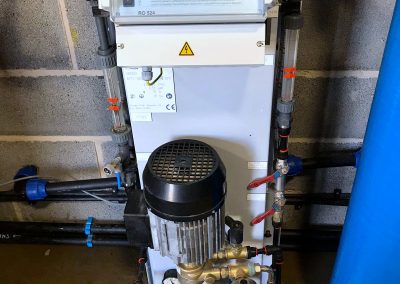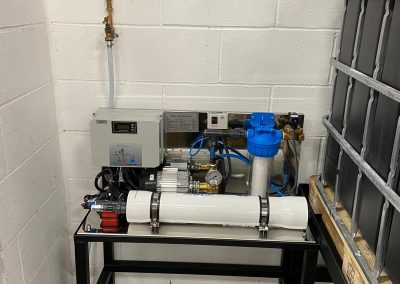A brief description
What is reverse osmosis?
Let us start with a definition of Osmosis.
If we consider a sugar solution in water then the water is the solvent and the sugar is a solute. If we separate a very sweet solution of sugar water and a weak solution of sugar water with a semipermeable membrane, water will pass from the weaker solution into the sweeter solution until each side is of equal sweetness.
If we were to exert pressure on the sweeter side then the water will flow in the opposite direction. This is reverse osmosis.
This process is used to create drinking water from a supply containing higher concentrations of dissolved material. So, for example a water supply with a high level of sodium may be treated by reverse osmosis to give on one side of the membrane a solution low in sodium (permeate) and on the other side of the membrane a solution containing a much higher concentration of sodium (concentrate). In a single stage reverse osmosis system, the permeate is the drinking water and the concentrate is flushed to drain.
Full description
How efficient is reverse osmosis?
The media used in a reverse osmosis system is a partially permeable membrane with pore sizes down at molecular levels. So tiny are the holes (0.0001 of a micron) that they will allow molecules of water to diffuse through the membrane, but restrict the passage of larger molecules. An RO membrane will remove between 95 and 99% of all unwanted ions or molecules from water.
Is reverse osmosis economic?
Single pass reverse osmosis units of the type commonly fitted under a kitchen sink such as our FRO-4 or 5 system will often reject to drain 3 litres of water for every 1 of pure water produced. So, no they are not very Eco-friendly. However, to pence per litre cost is very low compared to buying bottled water. Water produced from our undersink RO units typically costs between 2 to 3 pence per litre.
Is it safe to drink RO water?
There has been a case made that because RO water contains none of the natural minerals that are present in natural water and that drinking RO water will deplete the body in minerals, that it is harmful to humans. Since we do not rely on just water for keeping our bodies natural chemical balance, and that a normal relatively healthy diet will contain all the components required to keep our bodies in balance. For sure drinking RO water to an extreme degree will cause problems, but then so will drinking normal tap water to the same excess. There is no evidence at all to suggest that drinking RO water is harmful to health when consumed normally.
What does reverse osmosis remove from water?
Very effective at removing protozoa (Cryptosporidium, Giardia etc)
Very effective at removing bacteria (Campylobacter, Salmonella, Shigella, e. Coli)
Very effective removal of viruses (Hepatitis, Norovirus, Rotavirus etc)
95-98% removal of Sodium, Chlorides, Copper, Chromium, Lead, Calcium, Magnesium, Arsenic, Nitrate, Potassium, etc.
What is the advantage of reverse osmosis treatment?
Quite simply it is extremely effective at removing contaminants from water. There is nothing as effective as RO for producing high quality water.
As an undersink treatment system it produces high quality water very cheaply when compared to bottled water. These units now have the option of remineralising the water by introducing trace Calcium and Magnesium back into the water. Undersink units often work purely on water pressure so there is no power consumption.
What is the disadvantage of Reverse Osmosis?
With what appears to be a ‘fix all’ for water treatment it is not difficult to think that Reverse Osmosis should be used everywhere to produce our drinking water. Sadly, this is not always practical. There are certain applications where RO is really the only practical method of producing high quality drinking water, one of those areas is the production of drinking water from seawater. This is often the only option in certain countries e.g. Canaries, Cape Verde, Middle Eastern lands etc where natural water is scarce but seawater is abundant.
The main problem with reverse osmosis is that water is produced only very slowly. Some undersink units will produce perhaps ½ litre per hour of drinking water and so to supply a whole house introduces a problem of constant supply.
Some private water supplies may have no option but to use reverse osmosis. If the raw water were to contain over the prescribed limit of Sodium for example there is no option but to remove the sodium using reverse osmosis. In this case the treatment system would fill a storage tank and then a pump would distribute the water through the property.
Reverse osmosis for larger scale supplies will need pre-treatment for the removal of hardness and iron, both of which will contaminate the membrane very quickly and cause failure. This pre-treatment all adds to the cost of installation and running cost.
The initial cost of commercial RO makes it often uneconomic for a domestic installation and so we will only use it as a last resort and then only to overcome specific problems that cannot be solved by more normal treatment methods.
Posted by Steve Parker, 26/02/2020


